This document provides a comprehensive review of firefly algorithms. It begins with background on swarm intelligence and how firefly algorithms were inspired by the flashing lights of fireflies. It then describes the basic structure of firefly algorithms, including initializing a population of fireflies, evaluating their fitness, sorting by fitness, selecting the best solution, and moving fireflies toward more attractive solutions over generations. The document reviews applications of firefly algorithms in areas like continuous, combinatorial, and multi-objective optimization as well as engineering problems. It concludes by discussing exploration vs exploitation in firefly algorithms and directions for further development.
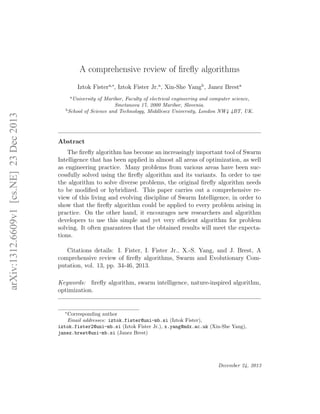
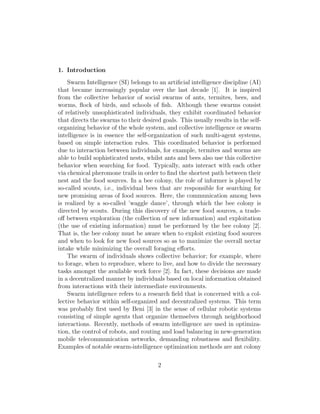






![re
y algorithm, swarm intelligence, nature-inspired algorithm,
optimization.
Corresponding author
Email addresses: iztok.fister@uni-mb.si (Iztok Fister),
iztok.fister2@uni-mb.si (Iztok Fister Jr.), x.yang@mdx.ac.uk (Xin-She Yang),
janez.brest@uni-mb.si (Janez Brest)
December 24, 2013
arXiv:1312.6609v1 [cs.NE] 23 Dec 2013](https://image.slidesharecdn.com/1312-141003105022-phpapp02/85/A-comprehensive-review-of-the-firefly-algorithms-9-320.jpg)

![cial intelligence discipline (AI)
that became increasingly popular over the last decade [1]. It is inspired
from the collective behavior of social swarms of ants, termites, bees, and
worms,
ock of birds, and schools of](https://image.slidesharecdn.com/1312-141003105022-phpapp02/85/A-comprehensive-review-of-the-firefly-algorithms-11-320.jpg)
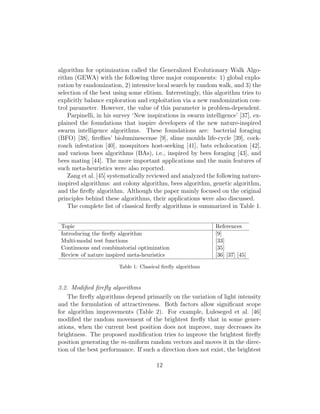
![nd the shortest path between their
nest and the food sources. In a bee colony, the role of informer is played by
so-called scouts, i.e., individual bees that are responsible for searching for
new promising areas of food sources. Here, the communication among bees
is realized by a so-called 'waggle dance', through which the bee colony is
directed by scouts. During this discovery of the new food sources, a trade-
o between exploration (the collection of new information) and exploitation
(the use of existing information) must be performed by the bee colony [2].
That is, the bee colony must be aware when to exploit existing food sources
and when to look for new food sources so as to maximize the overall nectar
intake while minimizing the overall foraging eorts.
The swarm of individuals shows collective behavior; for example, where
to forage, when to reproduce, where to live, and how to divide the necessary
tasks amongst the available work force [2]. In fact, these decisions are made
in a decentralized manner by individuals based on local information obtained
from interactions with their intermediate environments.
Swarm intelligence refers to a research](https://image.slidesharecdn.com/1312-141003105022-phpapp02/85/A-comprehensive-review-of-the-firefly-algorithms-13-320.jpg)

![rst used by Beni [3] in the sense of cellular robotic systems
consisting of simple agents that organize themselves through neighborhood
interactions. Recently, methods of swarm intelligence are used in optimiza-
tion, the control of robots, and routing and load balancing in new-generation
mobile telecommunication networks, demanding robustness and
exibility.
Examples of notable swarm-intelligence optimization methods are ant colony
2](https://image.slidesharecdn.com/1312-141003105022-phpapp02/85/A-comprehensive-review-of-the-firefly-algorithms-15-320.jpg)
![optimization (ACO) [4] [5], particle swarm optimization (PSO) [6], and ar-
ti](https://image.slidesharecdn.com/1312-141003105022-phpapp02/85/A-comprehensive-review-of-the-firefly-algorithms-16-320.jpg)
![cial bee colony (ABC) [7] [8]. Today, some of the more promising swarm-
intelligence optimization techniques include the](https://image.slidesharecdn.com/1312-141003105022-phpapp02/85/A-comprehensive-review-of-the-firefly-algorithms-17-320.jpg)
![re
y algorithm (FA) [9] [10]
[11] [12], cuckoo-search [13], and the bat algorithm [14], while new algorithms
such as the krill herd bio-inspired optimization algorithm [15] and algorithms
for clustering [16] [17] also emerged recently.
FA is one of the recent swarm intelligence methods developed by Yang [9]
in 2008 and is a kind of stochastic, nature-inspired, meta-heuristic algo-
rithm that can be applied for solving the hardest optimization problems (also
NP-hard problems). This algorithm belongs to stochastic algorithms. This
means, it uses a kind of randomization by searching for a set of solutions.
It is inspired by the
ashing lights of](https://image.slidesharecdn.com/1312-141003105022-phpapp02/85/A-comprehensive-review-of-the-firefly-algorithms-18-320.jpg)

![nd' or `to discover solutions by trial and error' [9]. In fact, there is no guar-
antee that the optimal solution will be found in a reasonable amount of time.
Finally, meta-heuristic means 'higher level', where the search process used in
algorithms is in
uenced by certain trade-o between randomization and local
search [9]. In the](https://image.slidesharecdn.com/1312-141003105022-phpapp02/85/A-comprehensive-review-of-the-firefly-algorithms-20-320.jpg)
![re
y algorithm, the `lower level' (heuristic) concentrates
on the generation of new solutions within a search space and thus, selects
the best solution for survival. On the other hand, randomization enables the
search process to avoid the solution being trapped into local optima. The
local search improves a candidate solution until improvements are detected,
i.e., places the solution in local optimum.
Each meta-heuristic search process depends on balancing between two
major components: exploration and exploitation [18]. Both terms were de-](https://image.slidesharecdn.com/1312-141003105022-phpapp02/85/A-comprehensive-review-of-the-firefly-algorithms-21-320.jpg)
![ned implicitly and are aected by the algorithm's control parameters. In the
sense of the natural bee colony, the actions of exploration and exploitation
has yet to be explained. For the meta-heuristic algorithms [19], the explo-
ration denotes the process of discovering the diverse solutions within the
search space, whilst exploitation means focusing the search process within
the vicinities of the best solutions, thus, exploiting the information discovered
so far.
Note that FA is population-based. The population-based algorithms
have the following advantages when compared with single-point search al-
gorithms [20]:
Building blocks are put together from dierent solutions through crossover.
Focusing a search again relies on the crossover, and means that if both
parents share the same value of a variable, then the ospring will also
3](https://image.slidesharecdn.com/1312-141003105022-phpapp02/85/A-comprehensive-review-of-the-firefly-algorithms-22-320.jpg)




![re
ies is their
ashing light. These lights have
two fundamental functions: to attract mating partners and to warn potential
predators. However, the
ashing lights obey more physical rules. On the one
hand, the light intensity I decreases as the distance r increases according to
the term I / 1=r2. This phenomenon inspired Yang [9] to develop the](https://image.slidesharecdn.com/1312-141003105022-phpapp02/85/A-comprehensive-review-of-the-firefly-algorithms-27-320.jpg)


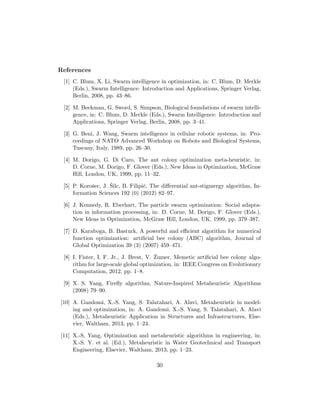



![re
ies especially inspired
the solution of graph coloring problems. On this basis, a distributed graph
coloring algorithm was developed by Lee [21]. Recently, the similar and
greater researched behavior of Japanese tree frogs inspired Hernandez and
Blum [22] into developing a more useful distributed graph coloring algorithm.
Therefore, the further development of the algorithm based on the oscillatory
behavior of](https://image.slidesharecdn.com/1312-141003105022-phpapp02/85/A-comprehensive-review-of-the-firefly-algorithms-34-320.jpg)


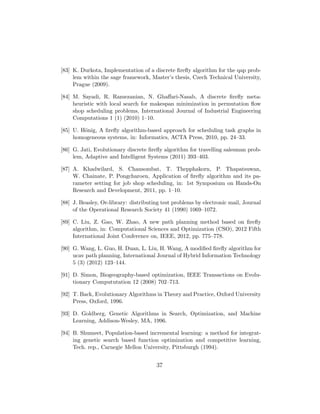


![problems. Section 4 brings the discussion of FA behavior and directions for
further development of this algorithms are covered. This paper concludes
with an overview of the work that has been performed within the discipline
of swarm intelligence.
2. Fire
y algorithm
2.1. Biological foundations
Fire
ies (Coleoptera: Lampyridae) are amongst the most charismatic
of all insects, and their spectacular courtship displays have inspired poets
and scientists alike [23]. Nowadays, more that 2,000 species exist worldwide.
Usually,](https://image.slidesharecdn.com/1312-141003105022-phpapp02/85/A-comprehensive-review-of-the-firefly-algorithms-40-320.jpg)


![re
ies, for example,
[24, 25, 26, 27, 28].
Fire
ies are characterized by their
ashing light produced by biochemi-
cal process bioluminescence. Such
ashing light may serve as the primary
courtship signals for mating. Besides attracting mating partners, the
ashing
light may also serve to warn o potential predators. Note that in some](https://image.slidesharecdn.com/1312-141003105022-phpapp02/85/A-comprehensive-review-of-the-firefly-algorithms-43-320.jpg)

